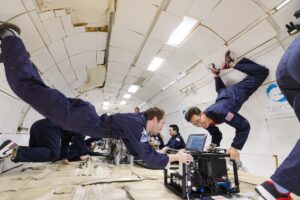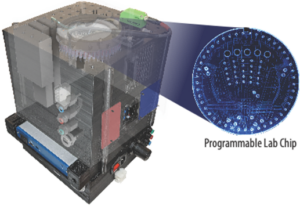 The Kim Lab, led by Dr. Jungkyu “Jay” Kim in the Department of Mechanical Engineering at the University of Utah, has successfully demonstrated the capabilities of their “Lab-on-a-Chip” in zero gravity, completing multiple biomarker assays over 100 cycles of microgravity. This technology offers a miniaturized and automated chemistry laboratory that could play an important role in measuring various biomarkers for astronaut health as we expand or manned exploration into the solar system.
The Kim Lab, led by Dr. Jungkyu “Jay” Kim in the Department of Mechanical Engineering at the University of Utah, has successfully demonstrated the capabilities of their “Lab-on-a-Chip” in zero gravity, completing multiple biomarker assays over 100 cycles of microgravity. This technology offers a miniaturized and automated chemistry laboratory that could play an important role in measuring various biomarkers for astronaut health as we expand or manned exploration into the solar system.
In space, it is impractical to use the large laboratories and equipment required for conducting clinical tests on Earth. Currently, WetLab-2 (now placed on the International Space Station), are only capable of performing astronaut health monitoring with limited capability. This necessitates the transition to smaller, more autonomous lab systems, such as “Lab-on-a-Chip.”
Graduate student Zachary Estlack and Dr. Kim, in collaboration with the Space Science Lab at UC Berkeley, designed and microfabricated a programmable “Lab-on-a-chip” that detects several biomarkers rapidly and precisely. For instance, hydrogen peroxide detected in a blood sample is a known stress biomarker. It reacts with chemical probes to produce highly fluorescent resorufin, a molecule that emits a specific wavelength of light when hit by a laser. The instrument reads fluorescent intensity to determine the amount of hydrogen peroxide in the blood. Using similar ways, this chip can assess many biomarkers for astronaut health monitoring simultaneously. Currently, there is not a practical health monitoring system that has been validated to use in space beyond simple vital sign measurements.
 “This work represents a major advance in improving space travel,” said Dr. Kim, “particularly for long term missions to Mars and beyond. Additionally, the technology itself has terrestrial applications as a rapid biomarker analysis system for monitoring the everyday health and temporal changes of people on earth. Things like the daily monitoring of blood sugar and pressure for individuals at risk for heart disease or diabetes, but with the addition of many more biomarkers to evaluate general health risks.”
“This work represents a major advance in improving space travel,” said Dr. Kim, “particularly for long term missions to Mars and beyond. Additionally, the technology itself has terrestrial applications as a rapid biomarker analysis system for monitoring the everyday health and temporal changes of people on earth. Things like the daily monitoring of blood sugar and pressure for individuals at risk for heart disease or diabetes, but with the addition of many more biomarkers to evaluate general health risks.”
The suborbital parabolic flights are critical to demonstrating the capability of this programmable Lab-on-a-Chip in the challenging microgravity environment where fluids behave differently. Typical mixing in microscale relies on diffusion to mix multiple liquid samples. However, if there is no gravitational component leading to convective or buoyant mixing, diffusion can behave differently. To manage those differences under various gravitational conditions, the group used microactuators to obtain consistent results on biomarker measurement. The group has also successfully demonstrated resilience to vibration and temperature, along with creating a highly portable solution. By demonstrating work in microgravity, they further demonstrated the Technology Readiness Level of the technology.
“A typical and appropriate analogy for the sense of microgravity is the feeling you get going over the crest of a hill on a roller coaster,” said Kim, “however, that feeling only lasts for a fraction of a second whereas the suborbital generated microgravity lasts for approximately 25~30 seconds. In addition, there are around 20 seconds of hypergravity in between each microgravity segment, during which your body feels twice as heavy as normal.”
Working under those conditions requires practice and months of preparation. The equipment needs to be fabricated so that it can be monitored regardless of position, due to the challenges of positioning yourself during microgravity cycles. They also designed the experiments for minimal human interaction to fit with the autonomous aims of the project.
“After testing over 100 cycles of microgravity, we have now proven that this lab chip performs effectively in various gravitational conditions,” said Kim. “Now, we need to continue the development and demonstrations of the biomarker assays in the lab to demonstrate the full capabilities of the platform that we have developed for multiplexing assays to enhance accuracy and precision of space diagnostics.”
You can visit the Kim Lab Website for more information, as well as from NASA’s article on “Advancing Space-Based Medical Technology Through Suborbital Flights.”